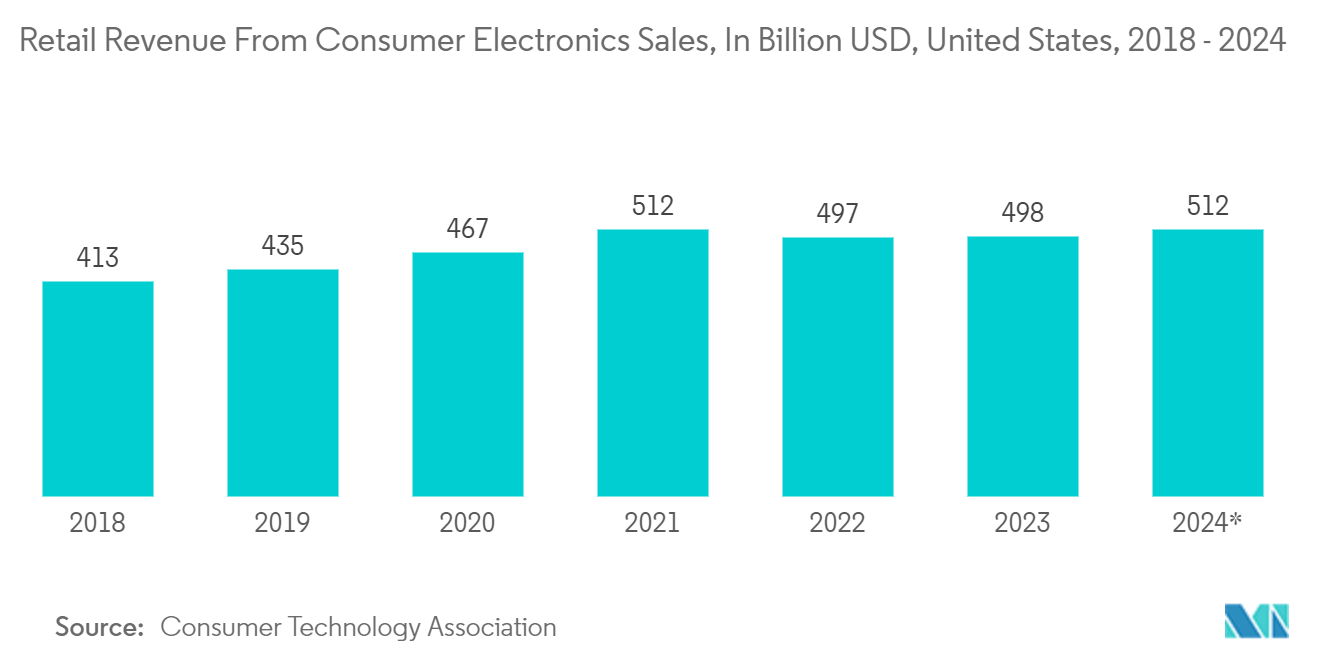Market Trends of North America Eye Tracking Solutions Industry
Consumer Electronics to Account for Significant Market Share
- Increased affordability and popularity of consumer electronics have affected the growth of eye-tracking solutions. Consumer electronics such as laptops, tablets, mobile phones, and smartwatches require complex implementation of smart sensors for process control, driving the market's growth in the customer electronics segment.
- According to GSMA, the no. of smartphone subscribers in North America is anticipated to reach 328 million by 2025. Moreover, by the same period, the region may witness an increase in the penetration rates of mobile subscribers (86%) and internet users (80%). Owing to the rise in the adoption of smartphones over the past few years, the industry has witnessed an increase in touchscreens, proximity sensors, and camera modules. Designing these devices necessitates eye-tracking solutions, which are, thus, expected to generate demand for the market studied over the forecast period.
- Development in the consumer electronics market in the region will also drive the studied market. For instance, in January 2023, Samsung added new products to its customizable home appliances lineup. The announcement was made in Las Vegas before the Consumer Electronics Show (CES) 2023. Some of the products added to Samsung's Bespoke line of home appliances include the Bespoke AI Oven and a more comprehensive selection of Bespoke refrigerator types.
- Wearable technology based on AI is generating a high demand for the eye-tracking solutions market. The increasing awareness and acceptance of smart wearable devices encourage eye-tracking companies to invest in innovative design tools for developing these enhanced products.
- During the time of the pandemic, QuickLogic Corporation, a developer of ultra-low power multi-core voice-enabled SoCs and Endpoint AI solutions, showcased how its products enable AI-based voice control for Endpoint IoT and hearable and wearable applications, including EOS S3 Voice and Sensor Processing Platform.

United States is Expected to Hold Significant Market Share
- There is also an improved need for eye-tracking devices in the retail FMCG sector. Eye-tracking devices and their algorithms are utilized to understand consumer behavior at retail stores. The algorithms help resolve what product layout will likely prompt a purchase at a store, how long a customer spends browsing a product, and what packaging gives the most product details for the customer's benefit.
- In March 2023, WiMi Hologram Cloud Inc. announced that it is developing a collaborative eye-tracking data visualization system. With the development of digital image processing technology and computer-supported collaborative work, eye-tracking technology enables the sharing of eye-tracking data and the perception of collaborative information and can be applied to collaborative interaction.
- In January 2022, Panasonic Automotive Systems Company of America, a tier one automotive supplier, unveiled their Augmented Reality HUD (AR HUD) 2.0, the first to include a new patented eye tracking system (ETS) enhancing the AR experience.
- Moreover, EyeTech Digital Systems, a provider of Health AI, announced the launch of EyeOn, an all-in-one, ultra-slim eye gaze tablet, during the Assistive Technology Industry Association conference in Orlando, FL. The EyeOn eye-tracking platform enables people with mobility and motor impairments to select, type, and speak entirely hands-free, using eye movement to control the device that measures just ' thick and weighs under 4.5 pounds.
- Further, in September 2022, Smart Eye announced that more than one million cars with Driver Monitoring System (DMS) software had been produced and sold globally. According to the company, out of the company's 14 automotive OEM customers, six have so far started series production of car models, including Smart Eye's innovative technology.



